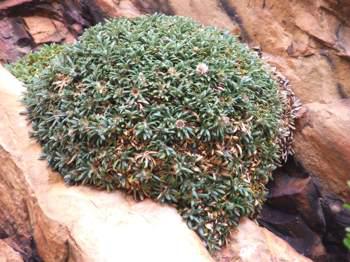Oldenburgia paradoxa
Oldenburgia paradoxa Less.
Family: Asteraceae
Common names: cliff cushion bush (Eng.); klipkreupelbos (Afr.)
Introduction
Oldenburgia paradoxa is an unusual cushion-shaped species of the daisy family that grows on rocks in the Cape mountains and looks like an alpine plant. It forms tight, hard, woody mounds from which its flower-heads peek between the dark-green leaves.

Description
Description
Olenburgia paradoxa is a dwarf, cushion-forming shrublet, up to 0.3m in height, with short, thick woody branches. The pllants form cushions up to 1 m in diameter on rocky outcrops. Leaves are narrowly-elliptic, alternately arranged to form rosettes at ends of short branches. They are 10 - 50 mm long, about 10 mm wide, shiny, dark green, simple, leathery. The undersides are densely white-woolly and the leaves are silky at base, with edges rolled under.

The plants produce a number of single, stalkless, tan-coloured capitula (flower heads) that nestle in the cushion of leaves. Each capitulum is about 25mm in diameter with several rows of firm, woolly bracts and small white florets in each head. Plants flower in late summer, winter and spring (from January to October), with a peak in late summer to autumn (April).
Conservation Status
Status
This species is noth threatned, and is Red Listed as LC (Least Concern).
Distribution and habitat
Distribution description
Oldenburgia paradoxa grows in high altitude mountain fynbos in the south-western and southern Cape from Villiersdorp to Avontuur.
Derivation of name and historical aspects
History
The genus Oldenburgia was named in honour of F.P. Oldenburg, who accompanied Thunberg and Masson on some of their travels in the Cape in the early 1770s. The genus consists of four species that are endemic to the Cape Province.
Ecology
Ecology
Oldenburgia paradoxa grows on rocks of Table Mountain Sandstone, rooting in crevices and forming large cushions at 600 - 1300m altitude. It is a compact cremnophyte or cliff dweller with a strong root probing crevices to fix it securely to cliffs and rocky outcrops. The root zone is therefore restricted, well drained and acidic. Observations indicate that it is killed by fire, but some escape by habitat or survive partial burning. This species forms a very hard cushion and is not grazed.

Seed is released when flowers mature and each disc floret forms a small parachute, with the seed at the base, that can be distributed by wind. It appears not to colonise sandy soils on open slopes, which suggest that seeds need to land in a rocky crevice to germinate and survive to adult stage.
Oldenburgia grandis is pollinated by nectar-feeding birds such as sunbirds and it is therefore possible that they also pollinate Oldenburgia paradoxa.
Uses
Use
Oldenburgia paradoxa is a novelty plant that will be of interest to specialist plant collectors or growers of alpine-like plants.

Growing Oldenburgia paradoxa
Grow
Oldenburgia paradoxa is grown from seed that has been treated with smoke or smoke extract.
The seeds are then sown into a well-drained, acidic, potting mixture and lightly covered. Place seed in trays, plugs or individual pots and keep in a well-ventilated, warm, sunny position where the seeds are protected from rain. Sowing directly into plugs or pots minimizes root disturbance and maximizes the number of surviving seedlings. Do not over water and allow the medium to dry out a little between watering. The seeds should germinate within two months.
It is good practice to protect the seeds from rotting by treating them with a pre-emergence fungicide for preventing damping off. These fungicides are available at your local nursery. The seedlings should be carefully potted at cotyledon stage before the first pair of true leaves develop, as this species does not react well to disturbance. Choose the smallest pots or grow-plugs available and well-drained, acidic soil to mimic the natural crevice habitat to which it is adapted. A mixture of equal parts of well-rotted pine bark or fine compost and coarse river sand is recommended. The small plants should be fed every week or second week with an organic liquid fertiliser. The seedlings are slow growing and should be kept in the smallest possible container and only re-potted when it becomes root-bound and difficult to water.
Oldenburgia paradoxa form such a tight cushion that selection of cuttings is not recommended. They might root, however, removal of cuttings will destroy the aesthetic form of the plant. Plants in pots at Kirstenbosch have been divided and survive as long as some root is retained on each section.
Oldenburgia paradoxa is a recommended as a pot plant as a special collectors specimen. It is slow growing and long lived.
References
- Bean, A. & Johns, A. 2005. Stellenbosch to Hermanus. South African wild flower guide 5. Botanical Society of South Africa, Cape Town.
- Bond, P. 1987. A revision of Oldenburgia (Asteraceae -- Mutisieae) South African Journal of Botany 53: 493 - 500.
- Manning, J. 2007. Field guide to the Fynbos. Struik, Cape Town
- Manning, J. & Goldblatt, 2012. Plants of the Greater Cape Floristic Region 1: the Core Cape Flora. Strelitzia 29. South African National Biodiversity Institute, Pretoria.
- Vlok, J. & Schutte-Vlok, A.L. 2010. Plants of the Klein Karoo. Umdaus Press, Hatfield
Credits
Anthony Hitchcock
Kirstenbosch National Botanical Garden
September 2014
Plant Attributes:
Plant Type: Shrub
SA Distribution: Western Cape
Soil type: Sandy
Flowering season: Late Summer, Autumn, Winter
PH: Acid
Flower colour: Brown, White
Aspect: Full Sun
Gardening skill: Challenging
Special Features:
Horticultural zones









Rate this article
Article well written and informative
Rate this plant
Is this an interesting plant?
Login to add your Comment
Back to topNot registered yet? Click here to register.